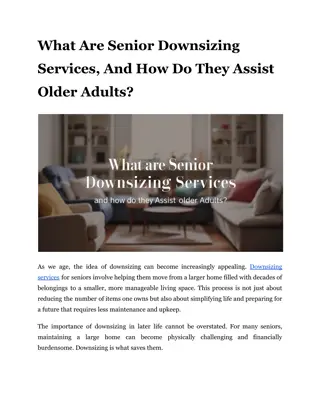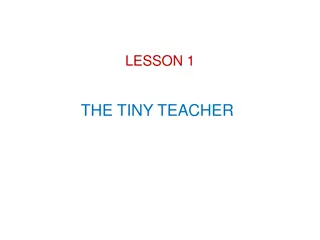
Tiny Living_ Downsizing to a Minimalist Lifestyle
Discover how downsizing to a minimalist lifestyle can bring simplicity and freedom. Tips for embracing tiny living and making the most of your space.
Download Presentation

Please find below an Image/Link to download the presentation.
The content on the website is provided AS IS for your information and personal use only. It may not be sold, licensed, or shared on other websites without obtaining consent from the author. Download presentation by click this link. If you encounter any issues during the download, it is possible that the publisher has removed the file from their server.
E N D
Presentation Transcript
Tiny Living: Downsizing to a Minimalist Lifestyle In an age where consumerism often reigns, many individuals are reconsidering their relationship with possessions and space. Tiny living, characterized by downsizing and embracing a minimalist lifestyle, is gaining traction as a practical and philosophical approach to modern living. This shift towards smaller living spaces and fewer possessions not only reflects a desire for financial freedom but also promotes sustainability, simplicity, and well-being. In a world filled with distractions and clutter, the idea of living simply can feel refreshing and liberating. Tiny homes invite us to reevaluate what is truly essential, leading to a more intentional way of life. With fewer square feet to maintain, individuals can redirect their energy toward experiences that enrich their lives traveling, exploring hobbies, or spending quality time with loved ones. The Rise of Tiny Living The tiny house movement began as a response to rising housing costs and a growing desire for environmental sustainability. As housing prices soared, many began
questioning the necessity of large homes filled with items that often go unused. Tiny living advocates emphasize that smaller spaces lead to more meaningful lives, focusing on experiences rather than material possessions. The movement has gained popularity, with countless blogs, documentaries, and communities dedicated to tiny living. Financial Freedom One of the most compelling reasons for downsizing is financial freedom. Maintaining a large home comes with significant costs, including mortgage payments, utilities, property taxes, and maintenance. By moving into a smaller space, individuals can reduce these expenses dramatically. This financial relief can lead to a more stress-free lifestyle, allowing people to save money, travel, or invest in experiences rather than things. Simplicity and Minimalism The minimalist lifestyle emphasizes simplicity and intentionality in daily living. Downsizing to a smaller home requires individuals to evaluate their belongings critically. This process encourages a mindset shift towards valuing experiences over possessions. Minimalism promotes decluttering not only physical space but also mental space, leading to reduced stress and increased focus on what truly matters. Emotional Challenges of Downsizing While the benefits of tiny living are numerous, the emotional challenges associated with downsizing can be significant, particularly for seniors. Transitioning to a smaller home often means parting with belongings that hold sentimental value. This can lead to feelings of grief, loss, or anxiety. Acknowledging these emotions is crucial in the downsizing process. The Role of Downsizing Assistance For seniors, downsizing can be especially daunting. Many have accumulated decades of possessions and may find it challenging to let go. Senior downsizing support offers a compassionate approach to this process, providing practical support and emotional guidance. Services often include organizing belongings, sorting items into keep, donate, or discard categories, and facilitating moves to smaller residences. Seniors benefit from professional assistance in various ways:
Emotional Support: Trained professionals can help seniors navigate the emotional aspects of downsizing, offering empathy and understanding during a time of transition. Practical Help: Downsizing assistance includes hands-on help with packing, moving, and setting up the new space, ensuring a smooth transition. Resource Management: Professionals can help identify which items are essential and how to dispose of or donate those that are no longer needed. Planning and Organization: Assistance with logistics can help seniors feel less overwhelmed and more in control of the process. Creating a Tiny Living Space Transitioning to a tiny living space requires thoughtful planning and creativity. Here are some strategies to make the most out of a smaller home: Maximize Space Efficiency Multi-Functional Furniture: Invest in furniture that serves multiple purposes, such as a sofa bed or a dining table that can also function as a workspace. Vertical Storage Solutions: Utilize wall space for shelves, hooks, and cabinets to keep the floor clear and make the area feel larger. Declutter Regularly: Make decluttering a habit. Regularly assess belongings to ensure that only necessary items remain. Create a Sense of Home Personal Touches: Even in a tiny space, personal items like photos, art, and mementos can create a warm atmosphere. Nature Elements: Incorporate plants and natural light to enhance the living space, making it feel more open and inviting. Define Areas: Use rugs or furniture placement to delineate areas within an open space, creating distinct zones for living, sleeping, and working. Embrace Community Tiny living often leads to a sense of community. Whether through tiny house villages or online groups, those who embrace this lifestyle can share experiences, challenges, and advice. Engaging with a community can provide a supportive network that enhances the downsizing experience.
The Impact on Well-Being Research indicates that minimalism can lead to improved mental health and overall well-being. Less clutter often translates to lower stress levels and increased productivity. Additionally, tiny living encourages individuals to focus on experiences rather than material possessions, which can lead to greater satisfaction and happiness. Living in a smaller space can also foster stronger relationships. With less room for distractions, individuals are more likely to spend quality time with loved ones, sharing experiences rather than possessions. This shift can lead to deeper connections and a more fulfilling life. The Bottom Line The journey towards tiny living and a minimalist lifestyle is not without its challenges, especially for seniors. However, with the right support and mindset, this transition can lead to greater financial freedom, emotional clarity, and an enriched quality of life. As individuals embrace tiny living and seek downsizing assistance for seniors, they discover that life can be less about what they own and more about how they choose to live. This mindset shift not only simplifies their surroundings but also opens up new opportunities for joy, connection, and experiences that truly matter. Site Article: Tiny Living: Downsizing to a Minimalist Lifestyle






















